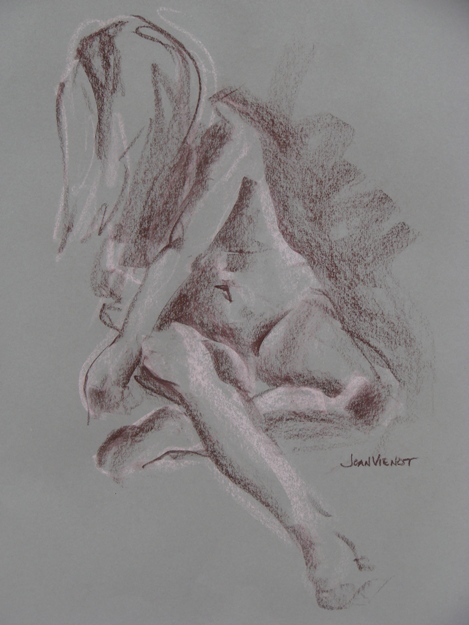
 Sometimes a model will bring props, which can imbue something completely different in the drawing. The model in my drawings shown here brought cuffs and a collar, which introduces a sexual component to the poses. For me, the image in my mind’s eye changed from nude to naked, and the atmosphere felt a little dangerous, and I wondered whether I should be asking what the “safe” word was, just in case!
Sometimes a model will bring props, which can imbue something completely different in the drawing. The model in my drawings shown here brought cuffs and a collar, which introduces a sexual component to the poses. For me, the image in my mind’s eye changed from nude to naked, and the atmosphere felt a little dangerous, and I wondered whether I should be asking what the “safe” word was, just in case!
Then I got busy and started drawing. I drew the seated pose on the left using Stabilo water-soluble pencils, putting just a touch of red in her hair and on her nipples to increase the sensationalism. For the same reason, I chose to use red paper for the drawing on the right, which was made with white Nupastel and graphite. The color red can heighten the viewer’s emotional or subconscious reaction.
These poses were made sexual by the props, and while drawing them I realized realized how very conservative I am with my art. Art history was one of my areas of emphasis for my degree, so I have seen plenty of art. I have seen outright obvious sexuality in art, both in classical work and contemporary. I always considered myself to be fairly accepting and open-minded towards other artists’ work, but when it came to me myself drawing a subject a little bit outside the boundaries of my own vanilla experience, I had to face my fear of rejection. After all, Victorian propriety is ingrained in our culture.
While some artists intend to offend, I mean no offense with my drawings. But I know that figure drawing as a genre does not have universal appeal. Some segments of our society are very sensitive about the human figure. Some cultures are averse to making representational images of people, feeling that it steals the soul. Others may view the human body as something shameful, instead of a thing of beauty. I have worked around swimming pools my entire life, so I am fairly comfortable being around people with very little clothing on, or none. The human form interests me as nothing else does. I would never be able to spend this much time drawing tree after tree after tree, for example — I would die of boredom. The figure remains ever interesting to me.
But I remember when I was a young adult, proudly showing off one of my drawings that was accepted into a juried art show at the university I was attending, and having a family member remark that it was “obscene, that I should be ashamed.” I was first of all aghast at the bad manners, but secondly, I felt pity for my critic, because that particular drawing had no gender or sexuality at all, and the figure was neither clothed nor unclothed. My teacher told me it was selected by the juror because of the sheer force of expression, and not for any technical merit. Nevertheless, for that family member, it evoked shame.
One of my friends often says “Observe and detach”, and I think that’s good advice when seeing something that is outside of our immediate construct, when our tendency is to judge it for being different, or to judge ourselves for paying any attention to it.







